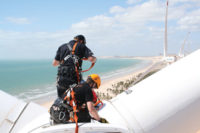History
ANSI/ASSE Z88.2-2015 has a history dating back to the 1930s that evolved up to the Z88.2 that OSHA adopted in 1969. That standard became the foundation of the respiratory program that has moved forward in regulatory activities. It has gone through several revisions, some controversial with appeals and lengthy completion times.
Why this standard is important
Z88.2 is a new standard that sets the pace for the respirator program for the next decade.
The 2015 version incorporates regulatory and national standards changes that have occurred during the past 23 years. For example, the 1992 version of the standard referred back to a 1972 NIOSH and Bureau of Mines joint approval and it points to 30 CFR Part 11; that was replaced in 1995 by NIOSH. The bureau is no longer involved in the approval of respirators, which is a big change incorporated into respiratory protection practices.
Hazards
If the wrong respirator is chosen, people can get sick or die.
One of the Z88.2 appendixes covers effective protection factors and it shows that when a respirator is worn only 50 percent of the time that it is needed, the wearer does not get any protection from the respirator. If you use a respirator for only 50 percent of the time it totally reduces the effectiveness of any respirator, no matter what the assigned protection factor (APF) is. It renders the respirator ineffective. Some believe that you may take the respirator off to talk to a coworker when in a hazardous location, but even for short periods this substantially reduces respirator effectiveness.
General Requirements
The section on program administration says there must be a “single, qualified individual” to ensure a respirator program is in place, and it adds a requirement for audits of that program.
Occupational safety and health professionals need to make sure that respirators are folded into the system and that senior management is involved.
Once you implement an effective respiratory protection program you only derive its effectiveness if it is actually followed. The respiratory protection manager needs to audit the program to be sure it has not drifted from what is expected.
According to Section 7.2 of the standard, proper respirator selection for any situation encompasses the nature of the hazard; worker activity and workplace factors; respirator use duration; respirator limitations; and use of approved respirators.
To identify the nature of the hazard, an OSH professional should perform a hazard assessment to determine whether the atmosphere is immediately dangerous to life and health (IDLH), non-IDLH, oxygen deficient or bioaerosol. To assess worker activity and location, the OSH professional must consider:
- how long a respirator will be used;
- whether the worker is in the hazardous area continuously or intermittently during a shift;
- physical demands made on the worker (e.g., whether the work rate is light, medium or heavy);
- work area layout;
- work activities;
- temperature and humidity of the work environment and any heat stress concerns related to other PPE worn.
Another factor is extreme physical exertion, which can cause the wearer to deplete a respirator’s air supply, thereby reducing its service life significantly
Establishing Cartridge & Canister Change Schedules
Chemical cartridges and canisters have a finite service life, which typically is different for each chemical and chemical mixture. Thus, the OSH professional must determine a cartridge’s effectiveness against the chemicals in use.
To protect workers, cartridges and canisters must be replaced before breakthrough occurs. Breakthrough is when the cartridge or canister no longer adsorbs all of the chemical; breakthrough time is the time required for a stated concentration of a chemical to be detected on the downstream side of a cartridge.
Annex A of Z88.2-2015 recommends these steps for establishing a change schedule:
- Gather workplace data for the respirator application.
- Obtain a service life estimate.
- Adjust the service life estimate to the work environment.
- Establish a change schedule.
Gather Workplace Data
To establish a change schedule, an OSH professional should document:
- workplace concentration of all gaseous and vaporous contaminants, especially those for which respiratory protection is required;
- workplace temperature;
- workplace relative humidity;
- work rate (breathing rate while performing the specific task);
- work periods and duration;
- cartridge/canister type and manufacturer.
In all cases, contaminant concentration, workplace temperature, relative humidity and work rate (flow rate through the cartridge or canister) affect cartridge or canister service life; higher concentrations of the same chemical shorten the service life.
Obtain a Service Life Estimate
Service life estimates are generated from cartridge/canister testing in the laboratory; cartridge/canister testing in the workplace; service life software; or cartridge/canister service life rules of thumb. Software is the most popular method for generating a service life estimate. Key inputs include workplace concentration, work rate estimate, temperature and humidity estimates, and chemical cartridge/canister variables. According to the guidance in Annex A, “The best service life estimate is based on the same conditions, or as close as possible, as the workplace conditions. This reduces extrapolation from the actual results to the workplace conditions” (p. 37).
Adjust Service-Life Estimate for the Workplace
The OSH professional may need to add safety factors or adjust service-life estimates based on how close the chemicals and values in the software are to actual workplace conditions. These adjustments should be made before establishing a change schedule.
Establish a Change Schedule
A change schedule is the time interval after which a used cartridge/canister is replaced with a new one. This schedule ensures that the cartridge/canister will be changed before the downstream concentration reaches an unacceptable level.
Cartridge/canister reuse is an important consideration. If the service-life estimate indicates that the cartridge will last much longer than a task’s duration, its reuse on a subsequent day may be an option. However, if migration of collected vapors during storage is likely, then reuse after storage should not be allowed and the change schedule should state that employees must use a new cartridge each day the task is performed.
In all cases, the change schedule should be convenient, and easy to track and enforce during breaks or at shift changes. The schedule should also be verified as being appropriate for the workplace.
Future Z88 standards activity
ANSI Z88 standards referenced in Z88.2 that are current or will be updated over the next few years. The first would be Z88.6, which provides medical surveillance requirements; and Z88.10, which addresses fit testing and the proper way to carry it out.
Source material:
©ASSE; reprinted with permission from the February 2016 issue of Professional Safety.
©ASSE; reprinted with permission from the September 2016 issue of Professional Safety.


